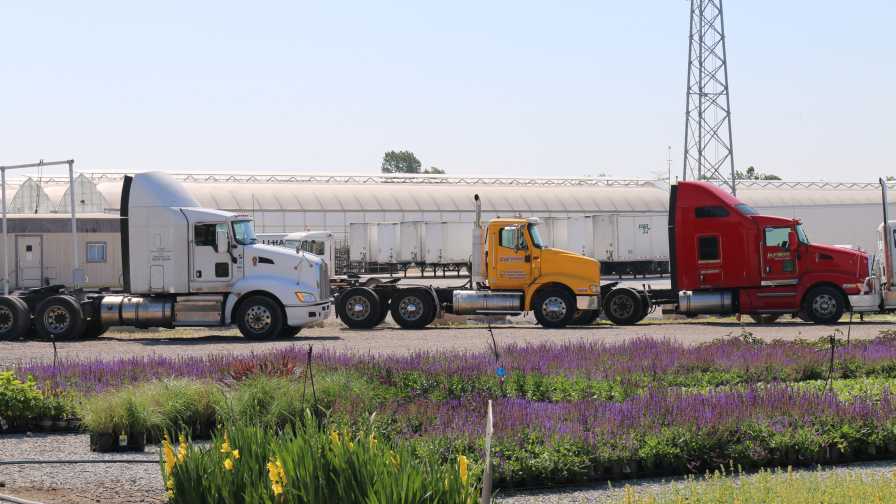What You Need to Know About New Trucking Regulations

Proposed rule changes could ease some grower concerns about the hours of service their truck drivers must record.
In late July, the U.S. Department of Transportation’s Federal Motor Carrier Safety Administration (FMCSA) announced it was seeking public comment on revising hours-of-service (HOS) regulations for delivery of agriculture commodities.
“The current regulations impose restrictions on the agriculture industry that lack the flexibility necessary for the unique realities of hauling agriculture commodities,” said U.S. Agriculture Secretary Sonny Perdue. “We look forward to continuing to work with Transportation Secretary Elaine Chao on revising these regulations.”
Currently, during harvesting and planting seasons as determined by each state, drivers transporting agricultural commodities are exempt from the hours of service (HOS) requirements from the source of the commodities to a location within a 100-air-mile radius from the source. The proposed rule authored by FMCSA was prompted by indications that the current definition of these terms may not be understood or enforced consistently when determining whether the HOS exemption applies.
In particular, the proposed rule would address the following issues:
- Increase safety and flexibility for the 30-minute break rule by tying the break requirement to eight hours of driving time without an interruption for at least 30 minutes and allowing the break to be satisfied by a driver using on duty, not driving status, rather than off duty.
- Modify the sleeper-berth exception to allow drivers to split their required 10 hours off duty into two periods: one period of at least seven consecutive hours in the sleeper berth and the other period of not less than two consecutive hours, either off duty or in the sleeper berth. Neither period would count against the driver’s 14-hour driving window.
- Allow one off-duty break of at least 30 minutes, but not more than three hours, that would pause a truck driver’s 14-hour driving window, provided the driver takes 10 consecutive hours off duty at the end of the work shift.
- Modify the adverse driving conditions exception by extending the maximum window by two hours, during which driving is permitted.
- Change the short-haul exception available to certain commercial drivers by lengthening the drivers’ maximum on-duty period from 12 to 14 hours and extending the distance limit within which the driver may operate from 100 air miles to 150 air miles.
Seeking Clarity on Exemptions
At the same time, Tal Coley, Director of Government Affairs for AmericanHort, says that (as of press time for Greenhouse Grower), there were Agricultural Trucking Relief bills for consideration in both the House and Senate. Coley also notes that one of the more intermediate focuses is to have a hearing in one of the transportation or agriculture committees to bring attention to the issue of defining ag commodities — perhaps even a markup or committee vote so the legislation would be a candidate for floor consideration.
“Efforts from our Impact Washington Summit in September focused on increasing sponsorships of the legislation and bringing more attention to the issue,” Coley says. “I think if more lawmakers are aware of the issue, as well as our argument for why we should be specifically included, it will set up better if the agency doesn’t see it the same way through their rulemaking process.”
If legislation eventually passes, Coley hopes it will allow growers to have peace of mind when it comes to utilizing the agricultural exemption associated with the Electronic Logging Device (ELD) mandate.
“Currently, there is a lot of confusion as to whether to use it — and for those that do, it potentially leads to difficult conversations with enforcement officers,” Coley says. “Clarity on what is considered an agricultural commodity is not only good for growers but for enforcement officers as well. Going forward, if the bills pass (or the agency ultimately decides we are specifically included), it sets up the industry well for future transportation regulations where agriculture is involved.”
The rigidness of the current rules has been one of the primary complaints with the ELD regulations so far. Until potential changes that also give drivers the flexibility to use additional hours of service are enacted, Coley says growers should familiarize themselves with the agricultural exemption and the advantages it provides.
Other Industries Monitoring Rules
It’s not just greenhouse growers who have much at stake when it comes to how the regulations are resolved. For example, Casey Reynolds, Executive Director of Turfgrass Producers International, says if the bills become law, it would solidify turfgrass sod’s classification as an agricultural commodity and allow producers to claim agriculture exemptions.
“It would also eliminate any expenses they would otherwise incur with ELDs and provide clarity among enforcement officials,” Reynolds says. “As of now, enforcement often varies by region, state, county, and/or the enforcement official’s interpretation of the current definition of an ag commodity. If sod haulers get stopped and questioned about whether or not sod is an ag commodity with regard to hours of service (HOS) or ELDs, then this bill would provide clarity, support, and documentation that it is in fact an ag commodity.”
If sod haulers cannot claim ag exemptions, Reynolds says they will then be subject to the full enforcement of hours of service and will be required to have ELDs in all trucks delivering sod.
“There is a lot of confusion out there right now among enforcement officials, and I have heard various stories from different states of some haulers getting stopped and cited, some not, and some have to be clarified in court,” Reynolds says.
The United Fresh Produce Association also is in the process of reviewing the changes contained in the FMCSA’s proposed rules.
“Based on our preliminary review, United Fresh is encouraged with the increased flexibility and safety for the 30-minute break rule and the changes to the short-haul exception available to certain commercial drivers by lengthening the drivers’ maximum on-duty period from 12 to 14 hours and extending the distance limit within which the driver may operate from 100 air miles to 150 air miles,” says Robert Guenther, Senior Vice President of Public Policy for United Fresh.










